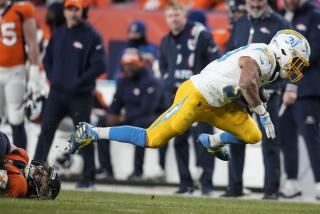Simplicity Is the Beauty of Cowboys’ Imaginative Offense
- Share via
ATLANTA — This much can be said for the rematch. These teams don’t play the same old conservative NFL game that most other teams play.
Their offensive schemes are two of the most unusual in football, and that largely explains why they are in Sunday’s Super Bowl.
The Buffalo Bills’ no-huddle, fast-break approach with Jim Kelly is the more distinctive, but the Dallas Cowboys might have the league’s most imaginative offense.
Most imaginative--and simplest.
Under Coach Jimmy Johnson, the defending Super Bowl champions aim not for touchdowns--or even first downs--but merely for five yards on every first-down play.
Johnson figures that if his players can repeatedly make four or five yards on first down, they can put so much second- and third-down pressure on their opponents that everything else will fall into place.
Johnson is like a good pitcher who always wants to be ahead of the hitter.
The most likely way to a sure gain, he also reasons, isn’t a power run--even with Emmitt Smith carrying the ball--but a short pass.
Accordingly, the Cowboys pass most of the time on first down.
But they don’t throw far. In a close game, their quarterback, Troy Aikman, barely reaches the scrimmage line with most of his passes--although he retreats so far, and whips the ball so rapidly and accurately, that they look longer.
Aikman’s easy first touchdown drive against the San Francisco 49ers last Sunday, the one that presaged the knockout, was typically sustained on two kinds of plays: draws and short passes that were carried for important gains.
During the 11-play drive, six passes were called. On one first-down pass, the ball was caught four yards beyond the line of scrimmage and carried an additional three. Another was caught at the line of scrimmage and advanced 28. Another was caught one yard behind the line and advanced 10.
On that opening, 80-yard move, Aikman twice abandoned called pass plays and scrambled, once for a first down, and then, on first and goal at the 49er 10-yard line, for five critical yards.
Dallas’ only long pass of the entire sequence was thrown on a reverse play by another Cowboy, who missed his target.
Except for the reverse-play surprise, that is how the Cowboys usually proceed--in game after game, quarter after quarter.
There is almost no chance for Aikman to throw an interception. And such is the skill and style of Smith that, one way or another, the Cowboys keep transforming little plays into big plays.
No other NFL offense is like this one. The philosophy is Johnson’s, the design is offensive coordinator Norv Turner’s, and the normally flawless execution is by Aikman, who has thrown primarily short passes throughout his career, and who thus is better equipped for Cowboy football than backup Bernie Kosar, or any other NFL veteran.
The simplicity of Johnson’s offense is staggering. It is based almost exclusively on three kinds of simple plays: dump passes, short slant passes and draw plays.
As the designated play-caller, Turner requires Aikman to look first for a slant-pass target almost every time. One wide receiver or the other, Michael Irvin or Alvin Harper, usually races a few steps forward before cutting in front of the cornerback and slanting in. If the defense has positioned a linebacker in the area, Aikman abandons the slant idea instantly and looks for a place to dump the ball.
He knows that the linebacker can’t be in two places, covering both the slant and the dump. Thus, Aikman’s job is simply to find the short target--Smith, fullback Daryl Johnston or tight end Jay Novacek--who is uncovered because the linebacker is busy elsewhere.
For variety, the Cowboys occasionally call a square-out pattern. Instead of slanting in, a wide receiver will break for the sideline.
And, occasionally, when the Cowboys reach their opponents’ 30-yard line, or thereabouts, Aikman lofts a long one into the end zone. But he invariably throws that ball beyond the entire defense. First to last, Aikman’s first responsibility is avoiding interceptions.
Despite its simplicity, Johnson’s system works because the defense has no good reason to guess whether the Cowboys have called a pass by Aikman or a fake-pass run by Smith. Because Smith is the best player in football, they have many kinds of draw plays--as well as a pitchout play or two--to get him into the open, where, Sunday, he scared everyone on the 49er team, and, no doubt, throughout the Bay Area.
Aikman was hurt the only time the Cowboys decided to turn their backs on the usual Johnson way.
That was at the start of the second half, which they began with a pitch to Smith. He isn’t Superman. He can be had if the opposition is reasonably sure he’s going to carry the ball, as the 49ers were that time. They expected the Cowboys to run in defense of their 28-7 lead.
So they creamed Smith, who was re-injured, losing four yards. And on second and 14, the Cowboys were in the one predicament they try hardest to avoid--a crisis exposing their quarterback to abuse and injury.
And the abuse came. And the injury.
Aikman was sacked, kneed in the head, and delivered to a hospital.
It was a reminder that, as a rule, it isn’t their offensive line that protects Aikman and Smith. It’s the way the Cowboys call their plays.
More to Read
Go beyond the scoreboard
Get the latest on L.A.'s teams in the daily Sports Report newsletter.
You may occasionally receive promotional content from the Los Angeles Times.










